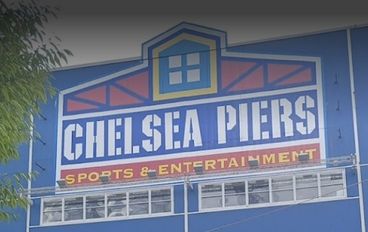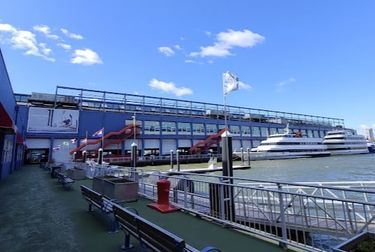
This is one of those places I knew I had to write about the second we decided to create this website. Every native NYC New Yorker is asked by visitors about this place all the time. What is that Blue place down the water? What do they do there? These are some of the most frequently asked questions from all my friends that visit.
There are four piers located on the Hudson River stretching from 17th to 23rd streets- these piers are called Chelsea Piers. Before Chelsea Piers became the popular stadium it is today, its past was tied to ships like RMS Lusitania and the RMS Titanic.
Moreover, it has a strong past relating to both World Wars, making the area around Chelsea Piers an integral part of the city’s transportation history for more than 100 years.
Today, Chelsea Piers is a popular destination where individuals can play, practice, learn, and compete. Before visiting the piers, you should learn more about its rich past.
A Gateway into the Past
The World’s Best Liners Have Been Here
The big ocean liners caused Chelsea Piers to become one of the busiest areas when it opened in 1910. Passenger ships traveling back and forth between New York and England docked here. The piers were big enough to hold five ocean liners at any time, allowing twenty smokestacks on the ships.
The ships that crossed Chelsea Piers transported famous, rich individuals, but an interesting fact that many are not aware of is that thousands of immigrants also came with them. The ships would stop at Chelsea and make their way into the United States from the piers to Ellis Island.
The RMS Titanic was Supposed to Dock at Chelsea Piers
The Titanic is still remembered as one of history’s worst accidents as an entire ship full of people drowned. Even though the ship did not make its way to the US, it was scheduled to arrive at Chelsea Piers on 16 April.
However, after the “unsinkable” ship hit an iceberg in North Atlantic, it brought 1,525 passengers to their death. This includes important New Yorkers such as John Jacob Astor IV and Benjamin Guggenheim. There were 675 additional passengers on board rescued by a Cunard liner, Carpathia. Four days after they were scheduled to arrive, Carpathia made its way to Chelsea Piers with the Titanic’s lifeboats.
The Lusitania Made its Way from Here

If the sinking of the Titanic was not bad enough, a few years later, Chelsea Piers fell victim to another tragic event- the sinking of the Lusitania. The Lusitania left New York from Chelsea Piers on 1 May 1915 and made its way to Liverpool, England. Even though the ship has received loads of warnings from Germans who were sinking ships going to England, the captain of Lusitania felt confident that he would outrun the Germans.
However, after half its journey, as the ship got to the south of Ireland, it was sunk by German U-boats. The captain had received many warnings while on the sea, but he thought the warnings were directed toward the upcoming fog.
As fate would have it, six days after it had set out, a German U-boat fired a single torpedo at the ship, and within 18 minutes, 1,195 individuals lost their lives. The sinking of this ship is what triggered the United States to enter World War I.
Designed by Warren and Wetmore
Many people are not aware that Chelsea Piers has been designed by a popular architectural firm known as Warren and Wetmore. By the end of the 19th century, more and more focus was put on making new piers on the west part of Manhattan. Warren and Wetmore set foot into the territory and designed the piers, along with the Grand Central Terminal.
The new design got rid of the collection of waterfront structures that had been around for decades. Instead, grand buildings were set up with pink granite exteriors. Even though Chelsea Piers has been around since 1910, it took 30 years of dialogue and eight years of construction for it to finally be built.
Was used as a Boarding Point in World War I and II
During World War I, Chelsea Piers was a famous spot for soldiers and the military to embark from. After the Great Depression, transatlantic travel fell, and individuals started to use Chelsea Piers more often.
In World War II, Chelsea Piers became popular again as American soldiers making their way to Europe used the area.
The Renovation Began in 1992
In 1976, there were plans to remake Chelsea Piers into a recreation center and station, but it was not until later that those plans materialized. This is mainly because citizens were not enthusiastic about the proposed changes, especially after all the history and events that Chelsea Piers had been linked to.
In the 80s, a demolition plan fell through, leaving Chelsea Piers to rot. By this time, Chelsea Piers consisted of nothing but rust and wood. It was not long before the New York State Department of Transportation started to develop and reconstruct the Chelsea Piers Sports and Entertainment Complex. The area became accessible by 1995, and locals saw huge developments, such as a golf club, field house, and sky rink. The renovation cost approximately $100 million but helped turn the neglected Chelsea Piers area into a busy stadium.
Film and Television Studios Use the Piers Today
After the redevelopment of Chelsea Piers, it became popular, and a large chunk of the public gained access to the stadium. It was not long before famous film and TV studios found their way to the piers and became big centers for film production.
In fact, former tenants of the area included Law and Order, Spin City, and Ready, Set, and Cok. Some popular movies that have been filmed at Chelsea Piers include Everyone Says I Love You, Six Degrees of Separation, You’ve Got Mail and The Preacher’s wife.
